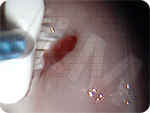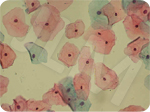During a smear test, also called a Pap (Papanicolaou) test, your doctor collects, with the aid of a small soft brush, a sample of cells from your cervix. These are placed in a vial and sent to a lab for examination under a microscope.
In the laboratory the cells are dyed and examined for any abnormalities.
The doctor acts here, very much like a gardener would check dead leave that have fallen from a tree for looking any signs of abnormality.
The Pap test is not painful. A speculum is used to widen the opening of the vagina so that the cervix and vagina can be examined.
The test is conducted with experienced doctors who ensure that only cells from the cervix are collected and exclude those from the vagina which are less likely to be prone to precancerous lesions. This avoids being reassured as to the absence of anomalies from cells that are not from the cervix.
The HAS (French National Authority for Health) recommends that sexually active women between 25 and 65 years of age should have 2 consecutive Pap tests, 1 year apart, that both return zero abnormalities and then continue to have a test at least once every 3 years.
The Pap test is not perfect and can return “false negative” results. This is why it is important to have the test regularly.
It has recently been suggested that the Pap test be replaced by or linked to the human papillomavirus (HPV) test in order to increase the sensitivity and avoid women being reassured by “false negative” results.
|
|
Taking a smear |
|





